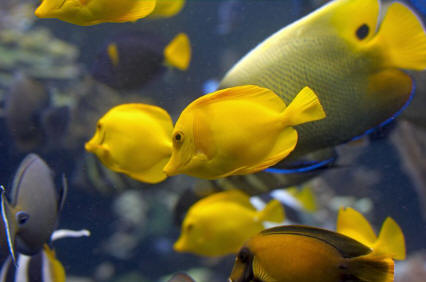Black Peacock Lionfish

|
Scientific Name: Pterois Volitans Price: Upon Request Origin: Indo-Pacific Family: Scorpaenidae NOT AVAILABLE NOW |
Technical Info
Temperature: 22 - 27 ℃
pH: 8.1 - 8.4
GH: 8 - 12
SG: 1.020 - 1.025
Max size: 35 cm
Min Tank size: 110 Ltr
Position in Aqua: No special swimming level
Description
Peacock lionfishes are clad in white stripes alternated with red, maroon, or brown. The fish has large venomous spines that protrude from the body like a mane, giving it the common name of the lionfish. The venomous spines make the fish inedible or deter most potential predators.
Food
Primarily a carnivore. Black Lionfish feed on live prey. Such as small fish, shrimp and crab.
Breeding
Volitans Lionfish will form small groups when breeding. A group will consist of one male and 2-7 females. During the courting period, the male fish will be even more aggressive than normally and it is not uncommon for males to kill each other. As the fishes get ready to spawn, the male will turn darker and become more uniformly colored while the female turns paler. Her belly, throat and mouth will change into a silvery white shade which makes her easy to distinguish in the dark. The male fish will locate a ripe female and place himself next to her on the substrate. He will prop himself up suing his ventral fins and look up towards the surface. After a while, he will start circling around her. Eventually, he will swim up to the surface and the female will follow while shaking her pectoral fins. Sometimes the pair will swim back down again and then up several times before any eggs are released. When it is time to release the eggs, the pair will swim right under the surface and the female will let go of two buoyant hollow mucus tubes. The tubes contain 2,000-15,000 eggs and will stay afloat right below the surface. After roughly 15 minutes the tubes will become filled with seawater and turn into oval balls. The sperms released by the male fish are capable of penetrating the mucus and fertilize the eggs inside. The larvae will hatch after roughly 36 hours. After another 2 ½ day or so, you can expect the larvae to start feeding on small ciliates in the water.
Compatible with
hey are not usually overtly aggressive and can make decent tank mates with fish of the same or larger size. They are hard wired to go after smaller fish and invertebrates such as shrimps. They should be kept in a semi-aggressive tank and should probably be left out of the community tank.
Note
The red lionfish is an inhabitant of near and offshore coral and rocky reefs to depths of 50 meters. The species shows a clear preference for sheltering under ledges or in caves or crevices by day.

